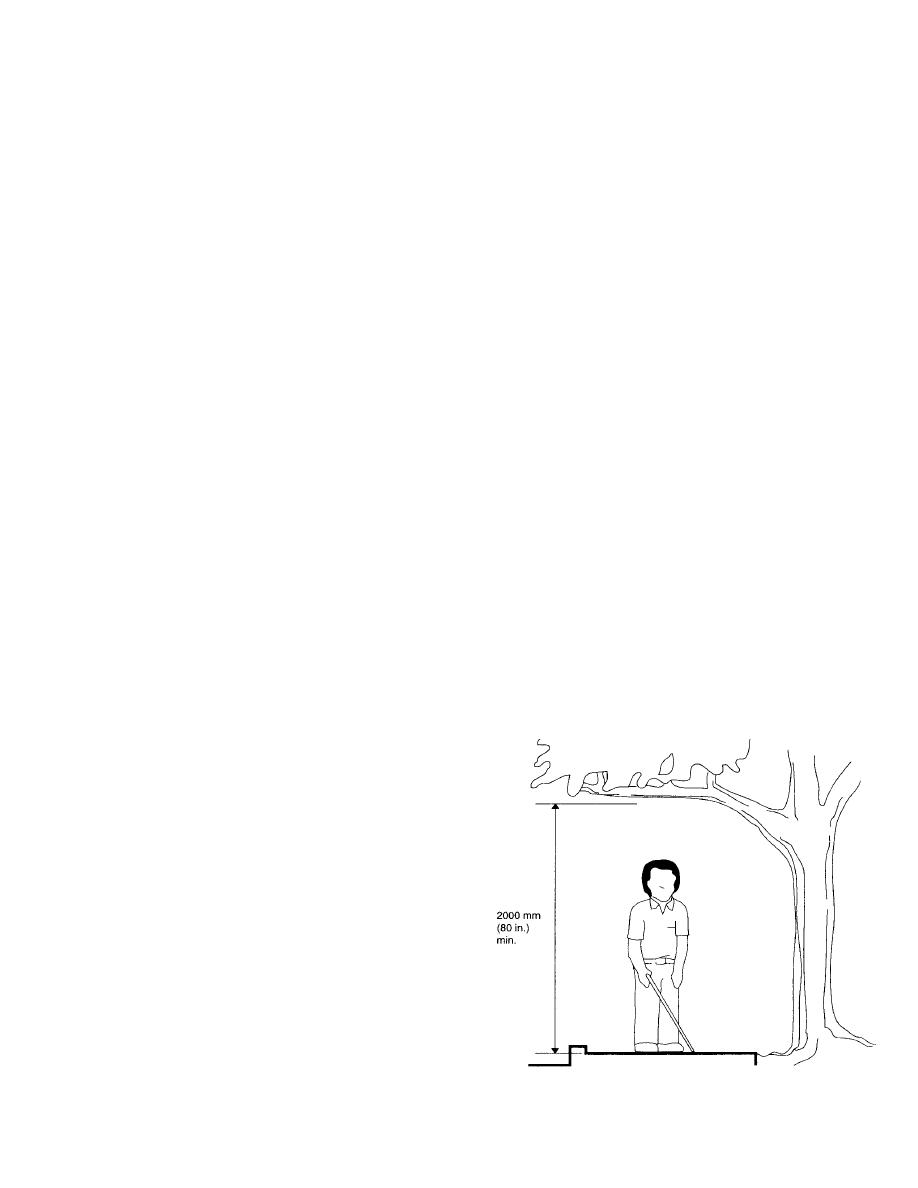
TM 5-803-11/AFJMAN 32-10139
(3) Accessible Pathways. Accessible pathways
e. Hardiness. Plants in children's play areas must
should be provided that allow children using wheel-
be capable of withstanding a high degree of human
chairs or assistive walking devices to get up close to
activity. Species that are quick-growing and heal
plants for play. Natural ground covers are not acces-
quickly after breaking should be selected.
f. Low-maintenance. Select plant material with
sible surfaces for people who use wheelchairs,
canes, walkers, or crutches.
limited maintenance requirements.
(4) Raised Beds and Transfer Points. Providing
(1) Plant Quality. Plants should be of a size
raised turf areas should be considered to allow chil-
and quality that will survive the high impact of a
dren who use wheelchairs to transfer onto the turf.
children's play area.
Raised beds or trellises for ground covers also pro-
(2) Plant Maintenance. Plant areas used by
vides opportunities for direct contact with plant ma-
children will never be maintenance-free. Designers
terial.
should consider that expert vegetation management
b. Shade. Shade is important for some children
should be provided in areas used by children. Prun-
and adults with disabilities. A diversity of shaded,
ing regimes and other maintenance procedures
partially shaded, and nonshaded areas should be
should respond to play requirements and child
provided to meet a wide range of needs.
safety. Plants should be selected that will minimize
c. Sensory Experiences. A variety of sensory expe-
maintenance requirements unless required for play.
riences should be provided using plants, such as
g. Size. Larger, mature plants are able to with-
texture, fragrance, wind effects, sound, and sea-
stand impact of human activity better than smaller,
sonal color. Plants with interesting smells and
younger plants. Shrubs should be selected which are
shapes are particularly beneficial to children with
as large as economy will allow. Trees with a minimum
visual disabilities.
50 mm (2-inch) diameter truck should be selected.
d. Hazards for Children With Limited Vision.
h. Access to Plants. Specific design strategies are
Low-hanging branches over main pathways should
needed to provide maximum access to plant materi-
be pruned under 2000 mm (80 inches) high (TM
als and to avoid creating hazards for children with
580313) (fig 121).
disabilities. Guidelines for providing access to plant
materials are provided in this chapter.
12-6. Child Safety.
i. Child Safety. Child safety requirements are an
Child safety factors should be considered in the
important selection criterion for plant materials in
selection and maintenance of plant materials.
children's outdoor play areas. These requirements
a. Surfacing Considerations. Falls from or onto
are described in this chapter.
plant material and slip hazards are important con-
siderations.
12-5. Accessibility.
(1) Safety Surface. Turf and natural ground
Plant materials can create intimate, touchable
covers should not be used as safety surfaces in play
elements that are accessible to children with dis-
equipment use zones.
abilities. These materials attract all children, pro-
viding excellent opportunities for interaction,
shared experiences, and integration. For this rea-
son, every effort should be made to integrate plants
into the design throughout the play area, rather
than restricting plants to segregated nature areas.
Guidelines for maximizing accessibility to plant ma-
terials follow.
a. Access to Plants. Opportunities for close con-
tact with plant materials should be provided.
(1) Accessible Height. Plant species should be
selected that provide play experience at a height of
460 to 1200 mm (18 to 48 inches). This optimizes
access for children who use wheelchairs or cannot
bend down. Containers or raised beds offer an excel-
lent means for bringing plant material to this height.
(2) Trees. In order to allow disabled children to
build an accessible tree house or to experience the
feeling of being in the treetops, low-branching and
weeping type trees and low-growing vegetation
should be provided.
Figure 121. Headroom Along Pathways.
12-3


 Previous Page
Previous Page
